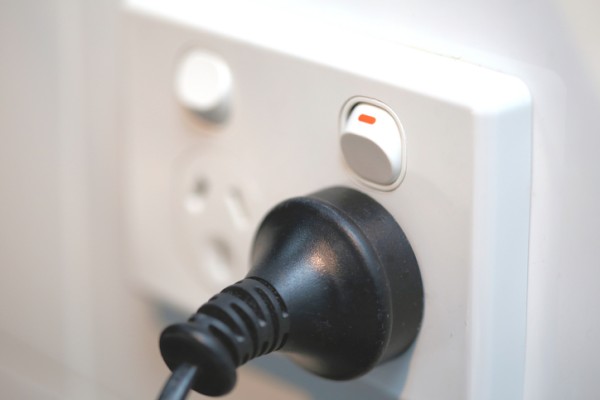
Power points, or general purpose outlets (GPOs), are a fundamental part of every home. Whether you’re building from scratch, renovating your kitchen or upgrading your outdoor entertaining area, knowing where and how power points can be installed is essential for both functionality and safety.
In 2025, the National Construction Code and AS/NZS 3000 (the Wiring Rules) continue to guide how GPOs must be placed and protected. Here’s what you need to know before installing or upgrading power points in your home.
What is a GPO?
A GPO (general purpose outlet) is the standard power point used in Australian homes. Most are rated at 10A and supply 240V, though higher-current outlets (15A, 20A or 32A) may be required for large appliances like ovens, spa pumps or power tools.
Power points come in various formats—single, double, quad, switched, unswitched and even with USB charging built-in. Outdoor and wet area outlets must be weatherproof and rated for their environment, often to a minimum of IP67.
Power point height and location rules
General living areas
The standard mounting height for GPOs in living rooms and bedrooms is at least 75mm from the finished floor level. This ensures cords and plugs are accessible and reduces the chance of water or dust ingress.
Kitchens
In kitchens, outlets should be installed at least 150mm above benchtops to avoid splash zones and allow for bulky appliance plugs. It’s also common practice to place GPOs inside appliance cupboards—like for dishwashers or rangehoods—on dedicated circuits.
Bathrooms
Bathroom GPOs are subject to strict clearance rules due to the risk of electric shock:
- They must be installed in Zone 3 only, at least 1.2m from showers, baths or sinks.
- If the sink has a basin capacity of 45L or less, the GPO must be at least 150mm horizontally and 400mm vertically from the sink edge.
- All bathroom outlets must be RCD-protected.
Outdoor power points
Outdoor GPOs allow you to safely power tools, lights, water features or outdoor kitchens—but they must be installed with care.
- Height: Mount between 300mm and 600mm above ground level. The maximum mounting height for accessibility is 2m.
- Protection: All outdoor outlets must be weatherproof (IP67 or higher) and have in-use covers to shield plugs from rain.
- Circuit design: Outdoor power points must be on a dedicated 20A branch circuit, and no more than 12 outlets can be connected to a single circuit.
- RCDs: Residual-current devices (RCDs) are mandatory for all outdoor power outlets to reduce the risk of electric shock.
Additionally, outdoor circuits should be designed with future load in mind—such as outdoor kitchens or electric vehicle (EV) chargers.
Circuit load and appliance planning
When renovating or extending your home, consider how many devices will be plugged in and whether certain appliances require dedicated circuits.
- Refrigerators, dishwashers, ovens and EV chargers often need their own protected circuits.
- If you’re installing multiple GPOs in one area, make sure they don’t overload a single circuit.
- All new and modified circuits must comply with AS/NZS 3000 and include RCD protection.
What’s new in 2025?
The NCC 2022 Amendment 1 came into effect on 1 May 2025, with minor updates to state-based provisions. But bigger changes are ahead. From October 2025, the new NCC 2025 will require:
- Switchboards to include space for future EV charging capacity.
- Load management systems in homes with high electrification (e.g. solar, battery storage).
- New wiring rules to support growing energy demands and safety needs.
While these don’t change how you place power points right now, they highlight the importance of future-proofing your electrical layout during a renovation.
Safety and legal responsibilities
All electrical work in Australia must be completed by a licensed electrician. DIY work on GPOs is illegal and highly dangerous. Your electrician should issue a certificate of compliance after installation, confirming the work meets all safety and regulatory standards.
If you’re unsure about the condition or compliance of existing outlets in an older home, a licensed sparkie can conduct an inspection and recommend upgrades.
Quick tips for renovators
- Choose GPOs with USB ports in bedrooms, kitchens and home offices for added convenience.
- Use vertical orientation and discreet locations (like inside cabinets) for a neater finish in kitchens and bathrooms.
- For outdoor spaces, ensure power points are sheltered from direct water exposure and positioned conveniently for outdoor entertaining or landscaping needs.
- Consider the long-term needs of your home—like solar, batteries or EVs—when planning outlet location and circuit load.
Final word
GPOs might seem like a small detail in a renovation, but getting them right can make a big difference in safety, convenience and future readiness. Whether you’re upgrading a bathroom, rewiring your kitchen or extending outdoors, proper placement, circuit design and protection are key.
As always, get professional advice and work with a licensed electrician. They’ll make sure everything is done by the book—and set your home up for safe, reliable power now and into the future.





